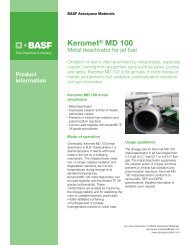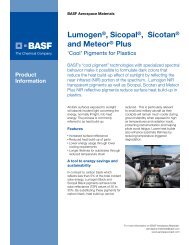Tinuvin® CarboProtect® - Aerospace Materials from BASF
Tinuvin® CarboProtect® - Aerospace Materials from BASF
Tinuvin® CarboProtect® - Aerospace Materials from BASF
Create successful ePaper yourself
Turn your PDF publications into a flip-book with our unique Google optimized e-Paper software.
Protection of epoxy-based compositesComposites based on aromatic polymers, e.g. carbon fibersin a thermoset aromatic epoxy matrix are inherently lightsensitive. Fundamental studies reveal that critical wavelengthscomprise both the UV range (280–380 nm) and the visualrange (400–420 nm). No traditional UV absorber technologyprotects as far out as 420 nm to prevent degradation ofepoxy-based CFRM. Tinuvin CarboProtect was designed todo just that: based on a very red-shifted, benzotriazole-basedtechnology, its spectral coverage comprises UV-A and UV-Bas well as the near visible wavelength range, with a distinctabsorption in the UV/Vis area (380–420 nm) as shown inFigure1. It features a high extinction coefficient and excellentphoto-permanence.1.25HPT-1BZT-1HPT-2BZT-21001.0080Absorbance0.750.50% Transmittance60403843693874260.25203910.00290 310 330 350 370 390 410 430 450Wavelength (nm)0290 310 330 350 370 390 410 430 450Wavelength (nm)Tinuvin ® CarboProtect ®Figure 1. Absorbance and transmittance of UV absorbers. Solutions of 20 mg/l (absorbance, left) and 80 mg/l (transmittance, right) in chloroform. Method: PerkinElmer UV/VIS/NIR spectrophotometer Lambda 650. HPT = high performance triazine; BZT = benzo-triazole; the numbers in the graph on the right-hand sideindicate the wavelengths where 50% transmittance is observed.For more information on <strong>BASF</strong> <strong>Aerospace</strong> <strong>Materials</strong>:aerospace.materials@basf.comwww.aerospace.basf.com
Weathering experiments illustrate the level of protectionthat Tinuvin CarboProtect provides to CFRM. After 2 yearsof natural weathering in Florida followed by 24 hours ofhumidity exposure, a CFRM protected by a solvent-based2K PUR coating containing hindered amine light stabilizer(HALS) and a conventional benzotriazole (BZT-3) UV absorberfails a cross-hatch/tape adhesion test catastrophically asillustrated by the whitening and film delamination (Figure 2,top left). Adding a high performance triazine (HPT-1) in additionto BZT-3 improves the UV protection but does not eliminatedeterioration as illustrated by strong whitening of the CFRMplaque (Figure 2, top right). The corresponding experimentswith Tinuvin CarboProtect instead of the conventional UVabsorber do not show any compromised adhesion of thecoating nor whitening (Figure 2, bottom left and right),illustrating the superior performance of the advanced,red-shifted UV absorber.Highlight carbon fiber weave in designelements in the cabin interiorThe protection that Tinuvin CarboProtect provides toepoxy-based substrates is so effective that it enablespigment-free, transparent coatings with UV blocking strongenough for exterior applications. In addition, carbon fiberapplications used in the cabin interior also require protection<strong>from</strong> UV radiation and can take advantage of TinuvinCarboProtect. The option to use transparent coatings overCFRM allows for the carbon fiber weaves to be displayedand utilized as design elements in the cabin interior, forexample in wall panels, decorative stripping, and laminatingas well as furniture in business jets. For enhanced styling,low levels of pigments can be added to introduce color andmetallic or pearlescent effects.2% BZT-31% HPT-12% BZT-32.0% Tinuvin ®CarboProtect ®2% HPT-12% Tinuvin ®CarboProtect ®Figure 2. Whitening after humidity exposure.Weathering experiments (24 months Floridaexposure) on epoxy-based CFRM, followed by24 h humidity exposure and a cross-hatch/tapeadhesion test. The CFRM were coated withsolvent-based 2K PUR, containing 1% of HALSand the specified types and amounts of UVabsorbers. HPT = high performance triazine;BZT = benzo-triazole.For more information on <strong>BASF</strong> <strong>Aerospace</strong> <strong>Materials</strong>:aerospace.materials@basf.comwww.aerospace.basf.com
Application guidelinesTinuvin CarboProtect is a solid UV absorber, designed forsolventborne coatings. While it was originally developed tostabilize carbon fiber reinforced epoxy, it is also suitable forcoatings, laminates and plastic substrates as well as basecoatings requiring strong protection both in the UV-A rangeand near visible spectral range.<strong>BASF</strong> Corporation<strong>Aerospace</strong> Team100 Campus DriveFlorham Park, NJ 07932E‐mail: aerospace.materials@basf.comRecommended applications are:n Coatings over carbon or glass fiber reinforced composites(CFRM, GFRM) based on epoxy resinn General coatings or substrates needing protection up to420 nmn General coatings over substrates very sensitive toUV-A energyFor outdoor applications, Tinuvin CarboProtect should becombined with a hindered amine light stabilizer such as Tinuvin123 (for acid catalyzed systems) or Tinuvin 292 (for 2K PUR).HALS/UV absorber combinations are synergistic and impartsuperior coating protection against gloss reduction, cracking,blistering, delamination, and color change. In basecoat/clearcoat systems, Tinuvin CarboProtect UV absorber shouldbe added to the clear coat for maximum efficiency, and theHALS to both the base and the clear coats. For optimumspectral coverage, it can be combined with a triazine-basedUV absorber such as Tinuvin 400 (in liquid paints) and Tinuvin405 (in powder coatings).Binder systemsTinuvin CarboProtect is recommended in binder systems,such as:n 1K and 2K PUR (acrylic/isocyanate, polyester/isocyanate, …)n Thermosetting (acrylic/melamine, polyester/melamine, …)n Thermoplastic (acrylic, vinylic, …)ConcentrationThe concentration of Tinuvin CarboProtect depends on dryfilm thickness and desired degree of protection. The amountrequired for optimum performance should be determined intrials covering a concentration range.Dry film thickness by weight on binder solids10–20 μm 10–5%20–40 μm 5–2.5%40–60 μm 2.5–1.25%www.aerospace.basf.comCarboProtect and Tinuvin are trademarks of <strong>BASF</strong>.Although all statements and information in thispublication are believed to be accurate and reliable,they are presented gratis and for guidance only, andrisks and liability for results obtained by use of theproducts or application of the suggestions describedare assumed by the user. NO WARRANTIES OF ANYKIND, EITHER EXPRESSED OR IMPLIED, INCLUDINGWARRANTIES OF MERCHANTABILITY OR FITNESSFOR A PARTICULAR PURPOSE, ARE MADEREGARDING PRODUCTS DESCRIBED ORDESIGNS, DATA OR INFORMATION SET FORTH.Statements or suggestions concerning possible use ofthe products are made without representation orwarranty that any such use is free of patentinfringement and are not recommendations to infringeany patent. The user should not assume that toxicitydata and safety measures are indicated or that othermeasures may not be required. © 2012 <strong>BASF</strong>









